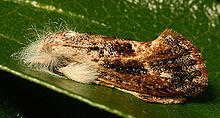
The Noctuidae, commonly known as owlet moths, cutworms or armyworms, are a family of moths. They are considered the most controversial family in the superfamily Noctuoidea because many of the clades are constantly changing, along with the other families of the Noctuoidea. It was considered the largest family in Lepidoptera for a long time, but after regrouping Lymantriinae, Catocalinae and Calpinae within the family Erebidae, the latter holds this title now. Currently, Noctuidae is the second largest family in Noctuoidea, with about 1,089 genera and 11,772 species. This classification is still contingent, as more changes continue to appear between Noctuidae and Erebidae.

The Ditrysia are a natural group or clade of insects in the lepidopteran order containing both butterflies and moths. They are so named because the female has two distinct sexual openings: one for mating, and the other for laying eggs.

Macrolepidoptera is a group within the insect order Lepidoptera. Traditionally used for the larger butterflies and moths as opposed to the "microlepidoptera", this group is artificial. However, it seems that by moving some taxa about, a monophyletic macrolepidoptera can be easily achieved. The two superfamilies Geometroidea and Noctuoidea account for roughly one-quarter of all known Lepidoptera.
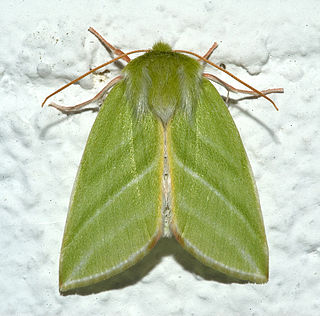
Nolidae is a family of moths with about 1,700 described species worldwide. They are mostly small with dull coloration, the main distinguishing feature being a silk cocoon with a vertical exit slit. The group is sometimes known as tuft moths, after the tufts of raised scales on the forewings of two subfamilies, Nolinae and Collomeninae. The larvae also tend to have muted colors and tufts of short hairs.
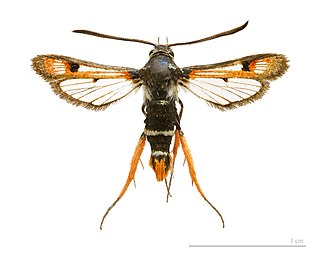
Sesioidea is a superfamily containing clearwing moths (Sesiidae), castniid moths (Castniidae) and little bear moths (Brachodidae). There is evidence from head and thoracic morphology that the first two families, internally feeding in plants as caterpillars, are sisters, whilst some brachodids are known to feed on leaf surfaces. Sesioidea is closely related to Cossoidea, which contains the also internal-feeding Goat and Leopard moths, and recent taxonomic treatments consider the sessoid families as part of Cossoidea sensu lato.

The Pyraloidea are a moth superfamily containing about 16,000 described species worldwide, and probably at least as many more remain to be described. They are generally fairly small moths, and as such, they have been traditionally associated with the paraphyletic Microlepidoptera.
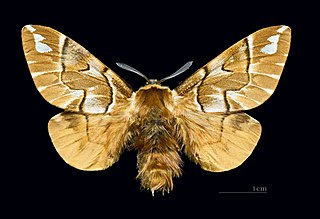
Endromidae is a family of moths consisting of 16 genera with 72 species. This relictual family is related to the families Carthaeidae, Anthelidae, and Phiditiidae as part of the bombycine group “CAPOPEM”.
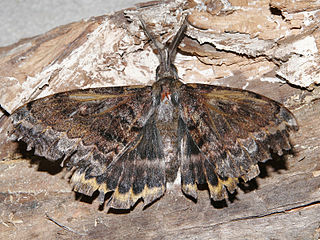
Anthelidae is a family of Australian lappet moths in the order Lepidoptera. It had earlier been considered to be part of the Lasiocampoidea superfamily, but a 2008 molecular phylogenetic study, supported by a 2011 study, resulted in reincluding the Anthelidae in the superfamily Bombycoidea.
Arrhenophaninae is a subfamily of moths in family Psychidae. It was once recognised as a family, but has been found deeply nested in Psychidae in phylogenetic studies.

The Plutellidae are a family of moths commonly known as the diamondback moths, named after the diamondback moth of European origin. It was once considered to have three subfamilies: Plutellinae, Praydinae, and Scythropiinae. Praydinae was later elevated to its own family, Praydidae, while Scythropiinae has variously been moved to Yponomeutidae or also elevated to its own family.
Acanthopteroctetidae is a small family of primitive moths with two described genera, Acanthopteroctetes and Catapterix, and a total of seven described species. They are known as the archaic sun moths.

The insect order Lepidoptera consists of moths, most of which are night-flying, and a derived group, mainly day-flying, called butterflies. Within Lepidoptera as a whole, the groups listed below before Glossata contain a few basal families accounting for less than 200 species; the bulk of Lepidoptera are in the Glossata. Similarly, within the Glossata, there are a few basal groups listed first, with the bulk of species in the Heteroneura. Basal groups within Heteroneura cannot be defined with as much confidence, as there are still some disputes concerning the proper relations among these groups. At the family level, however, most groups are well defined, and the families are commonly used by hobbyists and scientists alike.
Ceratophaga vicinella is a species of moth belonging to the family Tineidae. It has a restricted range in the southeastern United States, mainly in Florida and Mississippi.

The Obtectomera is a clade of macro-moths and butterflies, comprising over 100,000 species in at least 12 superfamilies.

Praydidae is a family of false ermine moths in the superfamily Yponomeutoidea. Though once considered a subfamily (Praydinae), a 2013 molecular analysis elevated it to family rank.

Phiditiidae is a family of moths. The family used to be placed as a subfamily (Phiditiinae) in the family Bombycidae.
Tridentaforma is a genus of moths of the Tridentaformidae family, the sole genus of the family. There is only one species in the genus, Tridentaforma fuscoleuca, which is found in California and Canada.
Meessiidae is a family of moths in the superfamily Tineoidea. There are at least 2 genera and more than 80 described species in Meessiidae.
The Macroheterocera are a well supported clade of moths that are closely related to butterflies and macro-moths.
